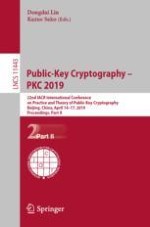2019 | Book
Public-Key Cryptography – PKC 2019
22nd IACR International Conference on Practice and Theory of Public-Key Cryptography, Beijing, China, April 14-17, 2019, Proceedings, Part II
Editors: Dongdai Lin, Kazue Sako
Publisher: Springer International Publishing
Book Series : Lecture Notes in Computer Science


